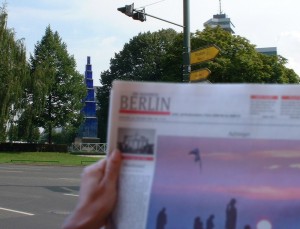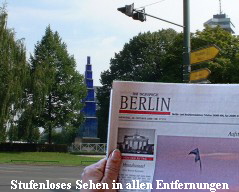
Presbyopia is associated with aging. In fact, the name presbyopia is derived from Greek words meaning “old eye”. The condition sets in as a natural development in our human vision when we reach our forties. The lenses in our eyes lose some of their elasticity and the ability to curve, and they no longer accommodate sufficiently. Thus we gradually lose some of our capacity to see near images clearly.
What are the first signs?
Hold a newspaper up close and the words appear blurred; push it farther away, and the words snap back into sharp focus. Attempting to thread a needle elicits amused glances from your children. You tend to need more light than you used to. These are all initial symptoms of presbyopia.
And what can you do about it?
A number of different types of eyeglasses are available these days to correct this condition. For an individual solution which takes your particular needs into account, we advise that you consult an eye care specialist and let him know what those professional and recreational needs are. Even though all corrective lenses for presbyopia will enable you to regain clear near vision, there are differences in the degree of lens functionality and comfort.
Simple reading glasses
Simple reading glasses or half-eye glasses are best suited for reading, writing or handcrafts, i.e. any activity which requires you to view images at a distance of 30 to 40 cm. When you lift your gaze, however , to look at things more distant, the objects of this focus will be less clear. Either you will need to constantly put on your glasses and take them off again, or you will be looking over the rim of your glasses when you wish to focus your sights on something farther away than the book in front of you.
Extended reading glasses
A special reading glass is available which allows a clear focus on things at a reading distance as well as things a little farther away (e.g. a computer screen). This is an ideal option for office workers. These glasses do not, however, allow you to see distant objects sharply.
Bifocal glasses
Bifocal glasses enable you to see near and distant images clearly, but a line separating the two sections extends all the way across the entire width of the lens. This line presents an obstacle for the eyes, since it forces them to leap directly from near to distant vision or vice versa.
Trifocal glasses
As we get older, the difference in corrective strength we need to enable clear near and far vision becomes greater. The two corrective strengths required no longer overlap, so that there is an intermediate distance in which our vision becomes unclear. In this case, we require trifocal lenses which cover near, far and intermediate vision. The problem is that these glasses feature a second separating line and thus an additional obstacle for the eyes given the threefold leap in focus.
Progressive-power or multifocal lenses
 Progressive power lenses are the most advanced type of corrective lens for people with presbyopia. The highly engineered optical surface of these lenses enables sharp vision at all distances. The wearer’s gaze can comfortably, i.e. gradually, progress from near to far vision. This progression is natural and causes no strain to the eyes. Progressive power lenses are extremely comfortable and will adapt to all individual focusing needs.
Progressive power lenses are the most advanced type of corrective lens for people with presbyopia. The highly engineered optical surface of these lenses enables sharp vision at all distances. The wearer’s gaze can comfortably, i.e. gradually, progress from near to far vision. This progression is natural and causes no strain to the eyes. Progressive power lenses are extremely comfortable and will adapt to all individual focusing needs.
Contact lenses
Multi-strength contact lenses enable people with presbyopia to see objects clearly at any distance and allow them to regain an unrestricted field of vision. And contact lenses are ideal for practically any sporting activity..


